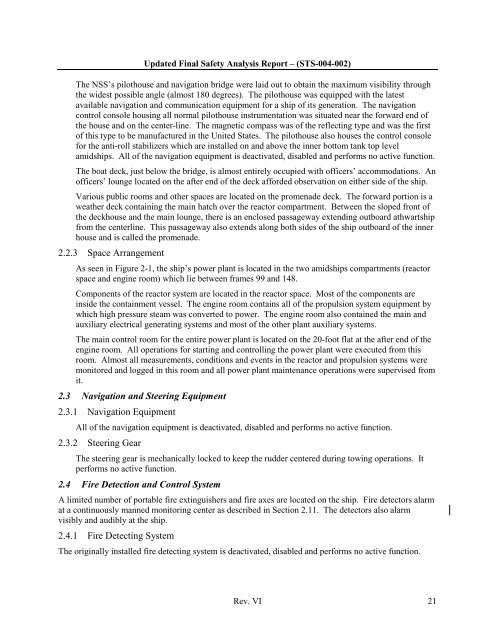10 CFR 50.71(e) - Maritime Administration - U.S. Department of ...
10 CFR 50.71(e) - Maritime Administration - U.S. Department of ...
10 CFR 50.71(e) - Maritime Administration - U.S. Department of ...
Create successful ePaper yourself
Turn your PDF publications into a flip-book with our unique Google optimized e-Paper software.
Updated Final Safety Analysis Report – (STS-004-002)The NSS’s pilothouse and navigation bridge were laid out to obtain the maximum visibility throughthe widest possible angle (almost 180 degrees). The pilothouse was equipped with the latestavailable navigation and communication equipment for a ship <strong>of</strong> its generation. The navigationcontrol console housing all normal pilothouse instrumentation was situated near the forward end <strong>of</strong>the house and on the center-line. The magnetic compass was <strong>of</strong> the reflecting type and was the first<strong>of</strong> this type to be manufactured in the United States. The pilothouse also houses the control consolefor the anti-roll stabilizers which are installed on and above the inner bottom tank top levelamidships. All <strong>of</strong> the navigation equipment is deactivated, disabled and performs no active function.The boat deck, just below the bridge, is almost entirely occupied with <strong>of</strong>ficers’ accommodations. An<strong>of</strong>ficers’ lounge located on the after end <strong>of</strong> the deck afforded observation on either side <strong>of</strong> the ship.Various public rooms and other spaces are located on the promenade deck. The forward portion is aweather deck containing the main hatch over the reactor compartment. Between the sloped front <strong>of</strong>the deckhouse and the main lounge, there is an enclosed passageway extending outboard athwartshipfrom the centerline. This passageway also extends along both sides <strong>of</strong> the ship outboard <strong>of</strong> the innerhouse and is called the promenade.2.2.3 Space ArrangementAs seen in Figure 2-1, the ship’s power plant is located in the two amidships compartments (reactorspace and engine room) which lie between frames 99 and 148.Components <strong>of</strong> the reactor system are located in the reactor space. Most <strong>of</strong> the components areinside the containment vessel. The engine room contains all <strong>of</strong> the propulsion system equipment bywhich high pressure steam was converted to power. The engine room also contained the main andauxiliary electrical generating systems and most <strong>of</strong> the other plant auxiliary systems.The main control room for the entire power plant is located on the 20-foot flat at the after end <strong>of</strong> theengine room. All operations for starting and controlling the power plant were executed from thisroom. Almost all measurements, conditions and events in the reactor and propulsion systems weremonitored and logged in this room and all power plant maintenance operations were supervised fromit.2.3 Navigation and Steering Equipment2.3.1 Navigation EquipmentAll <strong>of</strong> the navigation equipment is deactivated, disabled and performs no active function.2.3.2 Steering GearThe steering gear is mechanically locked to keep the rudder centered during towing operations. Itperforms no active function.2.4 Fire Detection and Control SystemA limited number <strong>of</strong> portable fire extinguishers and fire axes are located on the ship. Fire detectors alarmat a continuously manned monitoring center as described in Section 2.11. The detectors also alarmvisibly and audibly at the ship.2.4.1 Fire Detecting SystemThe originally installed fire detecting system is deactivated, disabled and performs no active function.Rev. VI 21
















